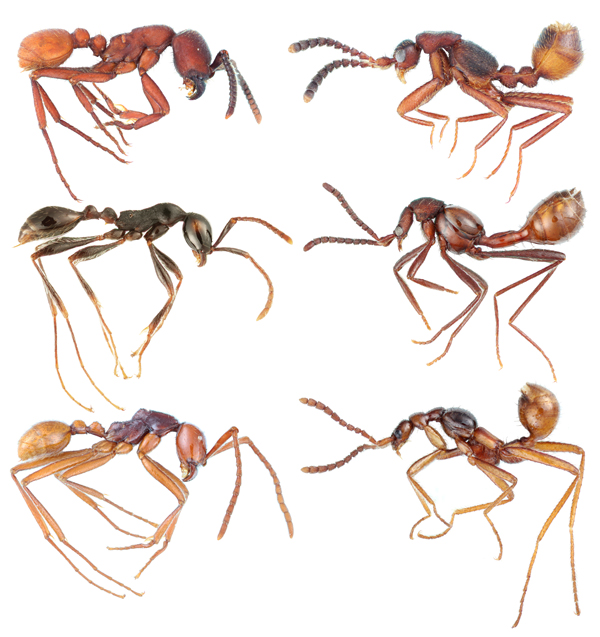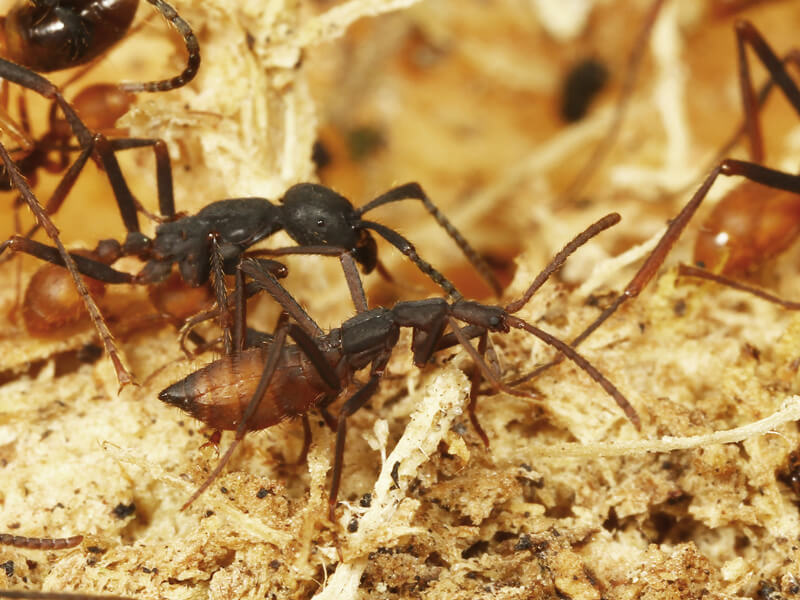Sometimes, the best way to handle an enemy is not to fight, but to fake. So it is with the hundreds of species — beetles, spiders, caterpillars and more — that mimic the forms or behaviors of ants, or the chemical signals that ants give off.
These impostors, called myrmecophiles, use these strategies to evade ants’ usually fierce defenses so they can live within the ants’ colonies, gaining protection, shelter and food. And they’ve been doing it for more than 100 million years, almost as long as ants themselves have been around.
Rove beetles — otherwise unremarkable, drab, solitary insects in the family Staphylinidae — are masters at this game, having evolved myrmecophily more than one hundred times over the eons, each time independently — a phenomenon known as convergent evolution. That evolutionary virtuosity presents biologists with a rare opportunity.
“You have a natural experiment with so many lineages that have undergone that change,” says Joe Parker, a biologist at the California Institute of Technology who studies the evolution and development of myrmecophile rove beetles. “It cuts to the core of a very enduring question in biology, which is how predictable evolution can possibly be.”

Evolution has modified the body plans of normal rove beetles (left) so that some myrmecophilous species look like ants (right). Left to right: Free-living Oxypoda and Atheta; ant-mimicking Ecitocryptus and Pseudomimeciton (top and side views).
CREDIT: JOSEPH PARKER AND MUNETOSHI MARUYAMA
The evolutionary biologist Stephen Jay Gould posited in his 1989 book Wonderful Life that the history of life has been so strongly shaped by idiosyncratic accidents that, if one rewound the tape of life, it would play out differently and unpredictably every time. But some examples of convergent evolution, like the myrmecophile rove beetles, suggest that evolution may be more predictable and repeatable than Gould believed.
Many examples of convergent evolution are relatively recent, such as the stickleback fish that repeatedly lost elements of their armor after becoming isolated in freshwater lakes as the last ice age wound down about 20,000 years ago. But the rove beetles present a much older and more complex pattern. “It’s this really unusual, ancient, deep-time system of predictable evolutionary change,” Parker says. “This is about as good an example as you’re going to get.”
To become a successful myrmecophile is no small feat. It requires dramatic and coordinated changes such as evolving new body shapes to mimic the appearance of ants, or parts of ants. One myrmecophile beetle, for example — Ecitophya — looks just like an ant. Another — Nymphister kronaueri — takes the shape and size of the ant’s gaster, its bulbous behind. The beetle clings to the ant and hitches a ride, disguised as a second gaster.

Three species of army ants (left column) and the rove beetles that mimic them (right column). From top to bottom: Nomamyrmex (ant) and Ecitocryptus (beetle); Aenictus (ant) and Giraffaenictus (beetle); Neivamyrmex (ant) and Diploeciton (beetle).
CREDIT: JOSEPH PARKER AND MUNETOSHI MARUYAMA
“These beetles are really cool. They can completely retract their appendages and their head, so there is no point of attack for the ants,” says Daniel Kronauer, an evolutionary biologist at Rockefeller University in New York. “They’re very well protected, like little tanks.” That’s important, because if an impostor is identified within the nest, it’s quickly game over.
Kronauer and his former postdoc Christoph von Beeren are particularly interested in the diverse adaptations among the myrmecophiles that live inside army ant nests, a topic they and coauthors discussed in a 2016 article in the Annual Review of Entomology. A study published in 2010 listed more than 300 animal species that depend on a single army ant species, Eciton burchellii.
Myrmecophily often requires chemical strategies, too, because each ant colony produces a unique, complex profile of hydrocarbon molecules on the colony members’ body surfaces, which ants use to distinguish nestmates from foreigners. To fit in, myrmecophiles often need to evolve new biosynthetic pathways to make these cuticular hydrocarbons, or new social behaviors like grooming the ants to steal the molecules so they can disguise themselves.
Parker is working to understand howthese coordinated changes occur. A special set of features predisposed rove beetles to evolve myrmecophily over and over, he thinks: First, rove beetles have shortened elytra, the hardened casings that protect the beetle wings. This leaves the abdomen partially exposed and vulnerable to predators. As a defense, the exposed abdomen contains a gland that, in free-living rove beetles, can produce and spray chemicals to deter predators.
That gland provided an evolutionary opportunity: Some myrmecophile rove beetles modified it to produce cuticular hydrocarbons that are similar to the chemical profile of the ants whose nests they infiltrate, or that allow the beetles to behaviorally manipulate the ants. This involved the evolution of new cell types in the gland that Parker's team is analyzing.
The team is focusing on a couple of rove beetle species that live inside the nests of velvety tree ants (Liometopum occidentale) in California: Sceptobius lativentris and Platyusa sonomae. Sceptobius beetles produce a chemical that quiets the ants and allows the beetles to groom them and steal their cuticular hydrocarbons. Chemically and behaviorally, Sceptobius is well integrated into the ant nest. In contrast, Platyusa lives at the periphery of the nest. It does not groom the ants and produces cuticular molecules that are not a perfect match to those of the velvety ant.

An Ecitophya rove beetle walks along with its Eciton army ant hosts.
CREDIT: TAKASHI KOMATSU
These two species represent different strategies for myrmecophily: Sceptobius is well adapted to the nest of velvety ants, but presumably could not live inside other ant nests, whereas Platyusa is less integrated, but could more easily adapt to the nests of similar ant species.
The researchers are comparing gland development and biochemistry in these two myrmecophiles to that in Dalotia coriaria, a solitary rove beetle that represents the ancestral form from which they developed. The team aims to pin down the new cell types, enzymes and biochemical pathways that allowed these distinct myrmecophile strategies to evolve.
Parker’s team also is studying the myriad chemicals produced in the gland and how they interact when mixed together. Different chemistries evolved for different facets of the beetles’ strategies: to defend themselves, to appease the ants or to mimic the ants and so disguise themselves as nestmates.
“There’s a lot of interesting discoveries for the future that are still waiting for us, because we know almost nothing about what all these myrmecophile glands produce,” says von Beeren, a postdoctoral fellow at the Technical University of Darmstadt in Germany.
The myrmecophile beetles also had to evolve neurobiologically. “They’ve undergone a really dramatic behavioral reversal from the defensive response, like a fight or flight response, to one of true social engagement where they seek out and interact intimately with the ants,” Parker says.
To study the neurobiological basis of this behavior change, his team is using transgenic beetles that have a calcium sensor that lights up in active brain cells, allowing the scientists to view neural activity in real time as a beetle interacts with ants. By comparing the neurobiological basis of social behavior in different myrmecophiles, Parker hopes to understand whether all social myrmecophiles use the same genetic and developmental tricks to build a social brain, or whether there may be many ways to achieve the same end.
Rove beetles may look dull and unprepossessing to the untrained eye, but to Parker and his team, they are diamonds in the rough. “This study system was there for the taking, but it was under the radar because of its obscurity,” Parker says. As they spill their secrets, the myrmecophile beetles may prove to be crucial in finally answering Gould’s famous question about the tape of life and the relative weight of inevitability and chance in evolution.




